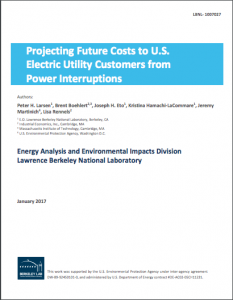Full Title: Projecting Future Costs to U.S. Electric Utility Customers from Power Interruptions
Author(s): Peter H. Larsen, Brent Boehlert, Joseph H. Eto, Kristina Hamachi-LaCommare, Jeremy Martinich, Lisa Rennels
Publisher(s): Lawrence Berkeley National Laboratory
Publication Date: January 1, 2017
Full Text: Download Resource
Description (excerpt):
Government policies, the deployment of smart grid technologies, and an increase in catastrophic weather events have focused attention on the reliability of electric power systems in the United States (U.S.) and around the world (Larsen et al. 2015, Larsen et al. 2016). Adverse weather, equipment failure, human error, vegetation management practices, wildlife, and other, occasionally unknown factors have been documented as causes of power interruptions (Hines et al. 2009; Larsen 2016a). The U.S. Department of Energy (DOE) reports that adverse weather is the most common cause of power interruptions, and that the weather-related impacts to the power system have increased significantly over the past twenty years (U.S. DOE 2015). Melillo et al. (2014) found that some extreme weather “have increased in recent decades…extreme weather events and water shortages are already interrupting energy supply and impacts are expected to increase in the future”. In addition to the potential for more frequent and extreme weather, aging power system infrastructure and an observed decrease in power system reliability highlight the importance of projecting the costs of future power interruptions to customers. Despite a general understanding that power system interruptions may increase in the future, long-term economic analyses for the U.S. have not been conducted. However, the need for such information could not be larger, particularly given the importance of power system reliability to the U.S. economy.
This analysis integrates regional models of power system reliability, projections from atmosphere-ocean general circulation models (AOGCMs), and results from the Interruption Cost Estimate (ICE) Calculator to estimate the potential economic implications of future reliability under different future severe weather and electricity system scenarios. This paper is organized as follows. We introduce the analysis method and data sources in section two. Section three contains the results and comments on the limitations of this modeling effort. Section four concludes by summarizing the findings and identifying some possible avenues for future research.
